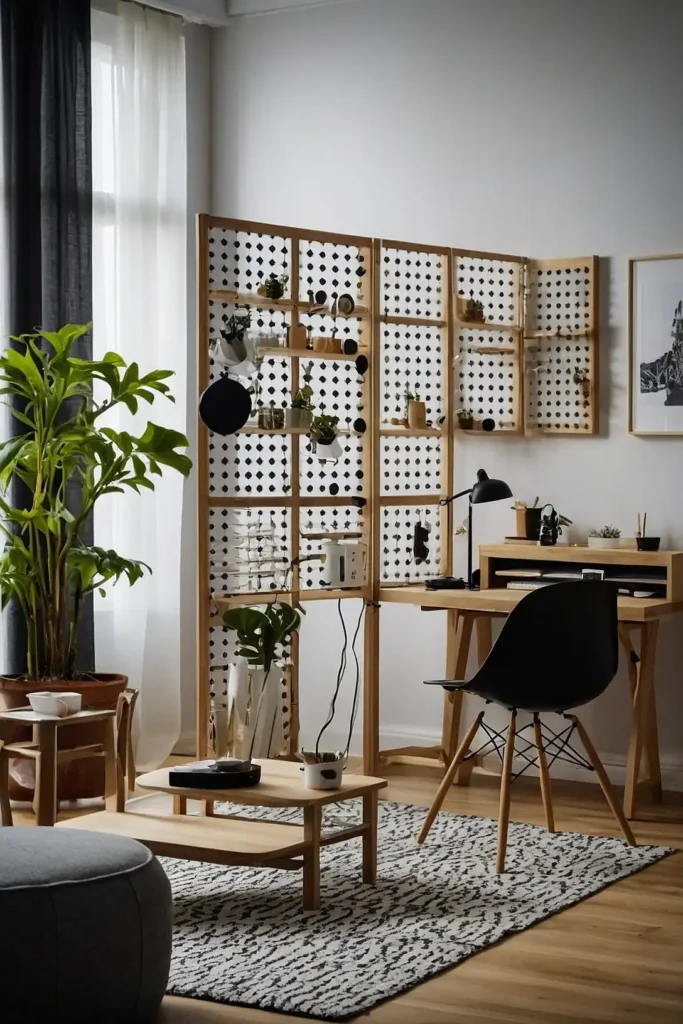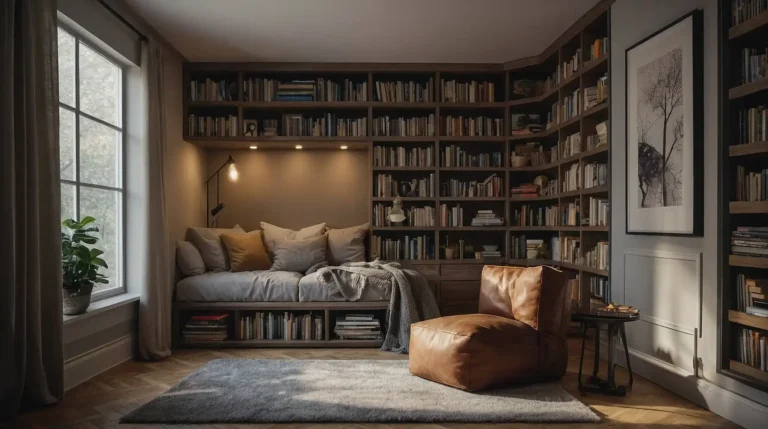27 Stunning IKEA Japandi Hacks That Transform Affordable Furniture Into Designer Pieces
Japandi style combines the best of Japanese minimalism and Scandinavian functionality, creating spaces that feel both calm and cozy.
This hybrid aesthetic celebrates natural materials, clean lines, and thoughtful simplicity.
With IKEA’s affordable basics as your canvas, you can easily achieve this sought-after look without breaking the bank.
The key lies in simple modifications that elevate standard pieces into something special.
Ready to bring harmonious Japandi vibes into your home?
These 27 IKEA hacks will show you how to transform everyday items into designer-worthy pieces that embody the perfect balance of warm minimalism.
1: IVAR Cabinet Transformation

Turn the simple IVAR cabinet into a statement Japandi storage piece by adding slim wooden legs and a natural oil finish.
This elevates the basic pine unit to new heights.
Replace the standard hardware with minimal wooden or black metal knobs for authentic Japandi flair.
The natural wood grain shows through the oil treatment, highlighting the organic texture that’s central to this aesthetic.
2: FROSTA Stool Side Table

Convert the humble FROSTA stool into a sculptural Japandi side table with minimal effort.
Sand the raw birch thoroughly and apply a matte black or dark walnut stain for sophisticated contrast.
Replace the standard legs with slimmer, tapered versions for a more refined silhouette.
This simple hack creates a versatile piece that functions as both extra seating and an elegant side table when needed.
3: LACK Shelf Room Divider

Transform multiple LACK shelves into a Japandi-inspired room divider by mounting them vertically at regular intervals.
This creates the effect of traditional Japanese shoji screens with modern functionality.
Paint the shelves in muted earth tones like clay, charcoal, or soft ecru.
Use the resulting divider to separate living areas while maintaining the open, airy quality valued in Japandi design.
4: KALLAX Tatami Platform

Repurpose a KALLAX shelf unit as the base for a low-profile Japandi bed platform.
This creates built-in storage while achieving the grounded aesthetic central to Japanese design.
Top the platform with a tatami mat or low-profile mattress for authentic style.
This sleeping arrangement brings your body closer to the ground, embodying the Japanese philosophy of connecting with the earth.
5: IKEA Paper Lantern Update

Upgrade basic IKEA paper lanterns like REGOLIT with natural wood rings and structured geometric shapes.
These simple modifications transform inexpensive lighting into artistic Japandi statement pieces.
Apply rice paper or thin wooden veneer strips to create patterns inspired by Japanese Kimiko woodworking.
The diffused light creates the warm, ambient glow that defines welcoming Japandi spaces.
6: MOPPE Mini Drawers Jewelry Box

Convert the versatile MOPPE mini drawer chest into a Japandi-style jewelry box with minimalist appeal.
Sand the raw wood thoroughly and apply a dark stain or muted paint color.
Replace the standard drawer holes with slim metal or wooden pulls in straight, clean lines.
The small proportions and multiple compartments make this perfect for organizing with the thoughtful intention that characterizes Japandi living.
7: SKOGSTA Table Refinishing

Enhance the already Japandi-leaning SKOGSTA dining table by sanding it thoroughly and applying a super matte protective finish.
This subtle change emphasizes the beautiful wood grain.
Add a thin black metal frame underneath to introduce the contrast typical in Japandi design.
This simple modification maintains the table’s minimal aesthetic while adding architectural interest and material contrast.
8: MALM Dresser with Wooden Overlay

Elevate the simple MALM dresser with thin wooden slats applied vertically across the drawer fronts. This adds texture and warmth essential to the Japandi aesthetic.
Choose walnut, oak, or ash for authentic natural appeal.
Replace the standard drawer pulls with recessed wooden handles or leather tabs for a refined finishing touch that maintains the clean-lined appeal.
9: BEKVÄM Step Stool Plant Stand

Transform the BEKVÄM step stool into a sculptural plant display by sanding it thoroughly and applying a muted, earthy stain.
This showcases houseplants at varying heights for visual interest.
Add small wooden dividers on the steps to create defined spaces for different pots.
Plants are essential elements in Japandi spaces, bringing nature indoors in a controlled, intentional manner.
10: SINNERLIG Pendant Customization

Modify the bamboo SINNERLIG pendant lamp by wrapping sections with thin black cotton cord in precise patterns.
This introduces contrast while maintaining natural material integrity.
Leave spaces between wrapped sections to create interesting light patterns on your walls.
This handcrafted approach honors the Japanese wabi-sabi philosophy that celebrates imperfection and natural materials.
11: RAST Dresser Cladding

Upgrade the basic RAST dresser with vertical wooden dowels applied to the drawer fronts.
This simple addition creates texture and architectural interest with minimal effort.
Stain the entire piece in a rich walnut or soft black finish for sophistication.
The vertical elements reference traditional Japanese architectural screens while maintaining Scandinavian functionality.
12: RIBBA Frame Wabi-Sabi Art Display

Repurpose RIBBA frames to display textured washi paper, pressed leaves, or minimalist ink drawings.
This creates calm, nature-inspired wall art central to Japandi aesthetics.
Paint the frames in muted clay tones or deep charcoal for refined contrast.
Arrange in asymmetrical groupings for the perfect balance between Japanese organic arrangement and Scandinavian order.
13: POÄNG Chair Makeover

Refresh the classic POÄNG chair with textured neutral fabric like raw linen or cotton in oatmeal, charcoal, or indigo.
These natural textiles add warmth to the clean Scandinavian form.
Sand and restain the wooden frame in a deeper tone for contrast.
This iconic chair’s curved lines already reference Japanese design influences, making it perfect for Japandi spaces.
14: STOCKHOLM Rug Pattern Painting

Customize a jute STOCKHOLM rug with geometric patterns hand-painted in muted indigo or clay tones.
This creates a custom floor covering with artisanal Japandi character.
Apply paint in simple, imperfect brush strokes to honor wabi-sabi principles.
The natural jute material combined with hand-applied details creates the perfect balance of Scandinavian and Japanese design elements.
15: BILLY Bookcase Room Divider

Transform connected BILLY bookcases into a sophisticated room divider by adding wooden slats to the back panels.
This creates a semi-transparent divider that maintains openness.
Paint the entire unit in a consistent muted tone like charcoal or taupe.
Arrange books and objects sparingly with ample negative space to honor the minimalist principles of Japandi design.
16: LOHALS Rug Wall Hanging

Repurpose the LOHALS jute rug as a textural wall hanging by adding a simple wooden dowel and leather strap hanging system.
This creates organic texture typical in Japandi interiors.
Add subtle details like thin black cotton cord wrapped around sections for contrast.
The natural fibers bring warmth and acoustic benefits while embodying the natural material focus of this aesthetic.
17: FADO Lamp Stone Effect

Transform the spherical FADO lamp with textured stone-effect spray paint in muted gray or sand tones.
This creates the appearance of a handcrafted ceramic piece with minimal effort.
Place on a wooden base for elevated presentation and material contrast.
The soft, diffused light creates the calm atmosphere essential to Japandi interiors without harsh brightness.
18: IVAR Cabinet Japanese-Inspired Doors

Replace standard IVAR cabinet doors with custom versions featuring kumiko-inspired wooden lattice work.
This introduces authentic Japanese craftsmanship elements into your storage.
Paint the cabinet base in a contrasting tone to your lattice for dimensional effect.
This combination honors Japanese woodworking traditions while maintaining the functional storage Scandinavian design values.
19: BJORKSNAS Bed Five-Minute Upgrade

Enhance the already Japandi-leaning BJORKSNAS bed by wrapping the headboard rails with thin black leather cord.
This simple addition adds tactile detail and visual contrast.
Sand the frame to smooth any factory finish and apply natural oil for protection.
This minimal bed design already embodies the low-profile aesthetic central to Japanese-influenced interiors.
20: SKÅDIS Pegboard Room Divider

Combine multiple SKÅDIS pegboards into a flexible room divider system by mounting them from ceiling tracks.
This creates adjustable privacy while maintaining light flow.
Paint in coordinating earth tones like clay, taupe, and charcoal for depth.
Add wooden hooks and accessories rather than the standard plastic ones for authentic Japandi material harmony.
21: NORRÅKER Bench Cushion Addition

Enhance the NORRÅKER bench with a custom cushion made from linen or cotton in subdued tones.
Add ties made from black cotton cord for an authentic finishing touch.
The cushion softens the minimal bench while maintaining clean lines.
Opt for slightly imperfect, handcrafted details that honor wabi-sabi principles like visible stitching or natural fabric variations.
22: SNIDAD Basket Contrast Painting

Customize natural SNIDAD rattan baskets by painting the bottom third in matte black or indigo.
This simple color-blocking creates designer-worthy storage with minimal effort.
The contrast highlights the natural texture of the woven rattan above it.
These baskets add essential texture while providing the practical storage solutions that both Japanese and Scandinavian design value.
23: VIKTIGT Chair Indigo Dip-Dye

Transform the natural rattan VIKTIGT chair with an indigo dip-dye technique on the lower portions.
This introduces color while honoring traditional Japanese textile techniques.
The gradient effect creates visual interest while maintaining natural elements.
This modification connects to Japanese indigo dyeing traditions while preserving Scandinavian simplicity in form.
24: HAVSTA Cabinet Rice Paper Doors

Replace glass panels in HAVSTA cabinets with traditional Japanese rice paper backed by thin wooden supports.
This diffuses the view of contents while adding authentic material elements.
Paint the cabinet frame in deep charcoal to contrast with the warm glow of the rice paper.
This modification references traditional shoji screens while maintaining practical storage functionality.
25: LISABO Table Japanese Joinery Details

Enhance the LISABO table by adding visible wooden dowels at each joint in contrasting wood tones.
This references traditional Japanese joinery techniques that celebrate construction methods.
Sand the entire piece thoroughly and finish with matte protective oil.
This simple detail honors the Japanese tradition of highlighting rather than hiding how pieces are constructed.
26: SVALNÄS Shelf Display Focus

Transform the SVALNÄS wall shelf system into a Japandi-inspired display by limiting items to careful curation.
Paint mounting brackets matte black for architectural contrast.
Arrange objects asymmetrically with intentional negative space between items.
This embraces the Japanese concept of “ma” (meaningful emptiness) while maintaining Scandinavian functional storage.
27: EKET Creative Configuration

Arrange EKET cubes in an asymmetrical pattern that references traditional Japanese step tansy cabinets.
This creates visual interest while maintaining practical storage.
Paint alternating cubes in complementary earth tones like clay, sand, and charcoal.
This configuration balances the Japanese appreciation for asymmetry with Scandinavian modular functionality.
Conclusion
These Japandi hacks transform basic IKEA pieces into designer-worthy elements for your home.
Start with a single project, focusing on natural materials, muted colors, and intentional simplicity to gradually build your perfectly balanced Japandi space.







